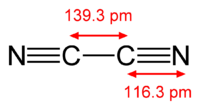Cyanogen: Difference between revisions
No edit summary |
Script assisted update of chemical identifiers from ChemSpider for the Chem/Drugbox validation project. |
||
| Line 10: | Line 10: | ||
| OtherNames = Cyanogen<br />Carbon nitride<br />Dicyan<br />Dicyanogen<br />Nitriloacetonitrile<br />Oxalic acid dinitrile<br />Oxalonitrile<br />Oxalyl cyanide |
| OtherNames = Cyanogen<br />Carbon nitride<br />Dicyan<br />Dicyanogen<br />Nitriloacetonitrile<br />Oxalic acid dinitrile<br />Oxalonitrile<br />Oxalyl cyanide |
||
| Section1 = {{Chembox Identifiers |
| Section1 = {{Chembox Identifiers |
||
| |
| ChemSpiderID = 9605 |
||
| PubChem = 9999 |
|||
| InChI = 1/C2N2/c3-1-2-4 |
|||
| SMILES = N#CC#N |
|||
| InChIKey = JMANVNJQNLATNU-UHFFFAOYAS |
|||
| CASNo = 460-19-5 |
|||
| CASNo_Ref = {{cascite}} |
| CASNo_Ref = {{cascite}} |
||
| RTECS = GT1925000 |
| RTECS = GT1925000 |
||
Revision as of 10:51, 27 January 2010

| |

| |
| Names | |
|---|---|
| IUPAC name
Ethanedinitrile
| |
| Other names
Cyanogen
Carbon nitride Dicyan Dicyanogen Nitriloacetonitrile Oxalic acid dinitrile Oxalonitrile Oxalyl cyanide | |
| Identifiers | |
3D model (JSmol)
|
|
| ChemSpider | |
| ECHA InfoCard | 100.006.643 |
| EC Number |
|
PubChem CID
|
|
| RTECS number |
|
| UN number | 1026 |
CompTox Dashboard (EPA)
|
|
| |
| |
| Properties | |
| C2N2 | |
| Molar mass | 52.04 g/mol |
| Density | 0.95 g/cm3 (liquid, −21 °C) |
| Melting point | −28 °C |
| Boiling point | −21 °C |
| 450 ml/100 ml (20 °C) | |
| Hazards | |
| NFPA 704 (fire diamond) | |
| Flash point | Flammable gas |
| Explosive limits | 6.6–42.6% |
| Related compounds | |
Except where otherwise noted, data are given for materials in their standard state (at 25 °C [77 °F], 100 kPa).
| |
Cyanogen is the chemical compound with the formula (CN)2. It is a colorless, toxic gas with a pungent odor. The molecule is a pseudohalogen. Cyanogen molecules consist of two CN groups — analogous to diatomic halogen molecules, such as Cl2, but far less oxidizing. The two cyano groups are bonded together at their carbon atoms: N≡C−C≡N, although other isomers have been detected.[1] Certain derivatives of cyanogen are also called “cyanogen” even though they contain only one CN group. For example cyanogen bromide has the formula NCBr.[2]
Cyanogen is the anhydride of oxamide:
- H2NC(O)C(O)NH2 → NCCN + 2 H2O
Preparation
Cyanogen is typically generated from cyanide compounds. One laboratory method entails thermal decomposition of mercuric cyanide:
- 2 Hg(CN)2 → (CN)2 + 2 HgCN
Alternatively, one can combine solutions of copper(II) salts (such as copper(II) sulfate) with cyanides, an unstable copper(II) cyanide is formed which rapidly decomposes into copper(I) cyanide and cyanogen.[3]
- 2 CuSO4 + 4 KCN → (CN)2 + 2 CuCN + 2 K2SO4
Industrially, it is created by the oxidation of hydrogen cyanide, usually using chlorine over an activated silicon dioxide catalyst or nitrogen dioxide over a copper salt. It is also formed when nitrogen and acetylene are reacted by an electrical spark or discharge.[4]
Paracyanogen
Paracyanogen is produced by polymerization of cyanogen through pyrolysis of heavy metal cyanides. [5]
History
Cyanogen has a long history and was most likely generated first by Carl Scheele around 1782 while he was studying hydrogen cyanide.[6][7] The first confirmed synthesis was reported 1802, when it was used to make what is now known as cyanogen chloride. It attained importance with the growth of the fertilizer industry in the late nineteenth century and is still an important intermediate in the production of many fertilizers. It is also used as a stabilizer in the production of nitrocellulose.
Safety
Like other inorganic cyanides, cyanogen is very toxic, as it undergoes reduction to cyanide, which binds more strongly than oxygen to the cytochrome c oxidase complex, thus interrupting the mitochondrial electron transfer chain. Cyanogen gas is an irritant to the eyes and respiratory system. Inhalation can lead to headache, dizziness, rapid pulse, nausea, vomiting, loss of consciousness, convulsions, and death, depending on exposure.[8]
Cyanogen produces the second hottest known natural flame (after carbon subnitride) with a temperature of over 4525°C (8180°F) when it burns in oxygen.[9]
See also
References
- ^
Ringer, Ashley (Jan 15), "Low-lying singlet excited states of isocyanogen", International Journal of Quantum Chemistry, vol. 106, no. 6, Wiley, pp. 1137–1140
{{citation}}: Check date values in:|date=and|year=/|date=mismatch (help) - ^ Hartman W. W.; Dreger, E. E. "Cyanogen Bromide" Organic Syntheses, Collected Volume 2, p.150 (1943).http://www.orgsyn.org/orgsyn/pdfs/CV2P0150.pdf
- ^ T. K. Brotherton, J. W. Lynn (1959). "The Synthesis And Chemistry Of Cyanogen". Chemical Reviews. 59 (5): 841–883. doi:10.1021/cr50029a003.
- ^ A. A. Breneman (1959). "Showing the Progress and Development of Processes for the manufacture of Cyanogen and its Derivates (in: THE FIXATION OF ATMOSPHERIC NITROGEN". Journal of the American Chemical Society. 11 (1): 2–28. doi:10.1021/ja02126a001.
- ^ <a href="http://www.thefreedictionary.com/Paracyanogen">Paracyanogen</a>
- ^ H. Bauer (1980). "Die ersten organisch-chemischen Synthesen". Naturwissenschaften. 67 (1): 1–6. doi:10.1007/BF00424496.
- ^ J. Gay-Lussac (1815). "?". Ann. Chim. Et phys. 96: 175.
- ^ Muir, GD (ed.) 1971, Hazards in the Chemical Laboratory, The Royal Institute of Chemistry, London.
- ^ Thomas, N.; Gaydon, A. G.; Brewer, L. (March 1952), "Cyanogen Flames and the Dissociation Energy of N2", The Journal of Chemical Physics, 20 (3): 369–374, doi:10.1063/1.1700426
{{citation}}: CS1 maint: multiple names: authors list (link)

